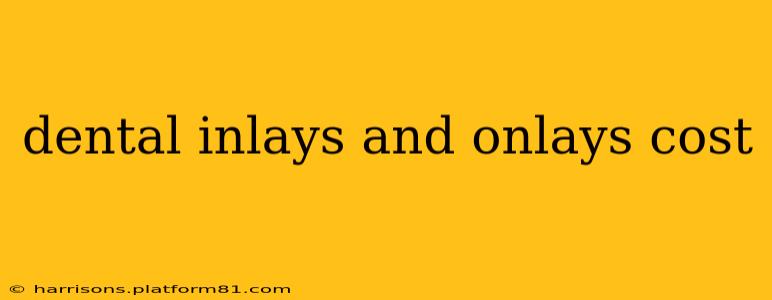Dental inlays and onlays are restorative treatments used to repair damaged teeth, offering a less invasive alternative to crowns. Understanding the cost of these procedures is crucial for budgeting and choosing the right treatment. The price varies significantly based on several factors, which we'll explore in detail.
What Factors Influence the Cost of Dental Inlays and Onlays?
Several factors contribute to the final cost of dental inlays and onlays, making it impossible to provide a single definitive price. These factors include:
- Size and Location of the Restoration: Larger restorations requiring more material and more complex procedures will naturally cost more. The location of the tooth within the mouth can also influence the difficulty of the procedure and thus the cost.
- Material Used: Different materials offer varying levels of strength, durability, and aesthetics. For instance, gold inlays and onlays are typically more expensive than porcelain or composite resin options. Porcelain is often preferred for its natural appearance.
- Dentist's Fees: Each dentist sets their own fees based on experience, location, overhead costs, and other factors. A specialist, such as an endodontist or prosthodontist, may charge more than a general dentist.
- Number of Teeth Requiring Treatment: The cost increases proportionally with the number of teeth needing inlays or onlays.
- Insurance Coverage: Dental insurance plans vary widely. Some may cover a portion of the cost, while others may offer minimal or no coverage. It’s vital to check your policy's specifics before proceeding.
- Additional Procedures: If additional procedures are necessary, such as root canals or extractions, the total cost will increase.
- Geographic Location: Costs can vary significantly based on geographic location. Dental practices in higher-cost-of-living areas often charge more.
What is the Average Cost of Dental Inlays and Onlays?
While pinpointing an exact average is difficult due to the many variables, a reasonable estimate for a single inlay or onlay is between $800 and $3,000. However, it's crucial to remember that this is a broad range. The actual cost will depend heavily on the factors outlined above. It's always best to get a detailed quote from your dentist after a thorough examination.
How Much Do Dental Inlays Cost Compared to Onlays?
In general, inlays are slightly less expensive than onlays. This is because inlays cover only the chewing surface of the tooth, while onlays cover a larger area, including at least one cusp (the pointed part of the tooth). The increased complexity and material usage of onlays naturally lead to a higher cost.
Are Dental Inlays and Onlays Covered by Insurance?
Insurance coverage for inlays and onlays varies considerably depending on your specific plan. Many plans consider them a restorative procedure and might cover a portion of the cost. However, the extent of coverage depends on factors such as the type of material used, the complexity of the procedure, and your plan's specifics. It's crucial to contact your insurance provider directly to determine your coverage before scheduling treatment.
What are the Alternatives to Dental Inlays and Onlays?
Depending on the extent of tooth damage, alternatives to inlays and onlays include:
- Fillings: For smaller cavities, fillings made of composite resin or amalgam can be a less expensive solution.
- Crowns: If the tooth is significantly damaged, a crown may be necessary, which completely covers the visible part of the tooth. Crowns are generally more expensive than inlays and onlays.
How Can I Find Affordable Dental Inlays and Onlays?
Several strategies can help you find affordable treatment:
- Check with Multiple Dentists: Getting quotes from several dentists allows you to compare prices and choose the most suitable option.
- Ask About Payment Plans: Many dental practices offer payment plans or financing options to make treatment more manageable.
- Explore Dental Savings Plans: Various discount plans offer reduced rates on dental procedures.
- Consider Your Insurance Coverage: Understanding your insurance benefits can significantly impact the out-of-pocket cost.
Disclaimer: This information is for general knowledge and does not constitute medical advice. Always consult with a qualified dental professional for personalized assessment and treatment recommendations. The cost estimates provided are approximate and can vary widely depending on individual circumstances.
